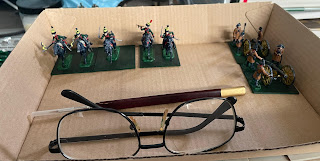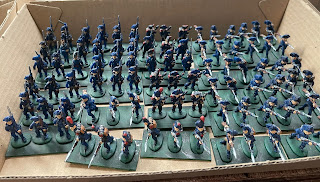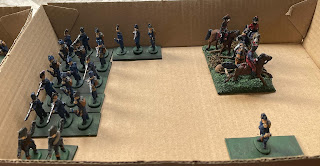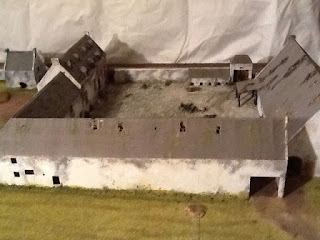"Time to reinvent the wheel", as Joe astutely stated in a comment to my first post in this 'series'. Like lots of wargamers, I have always adapted and even had a go at writing rules. It is little wonder that many, many (many) sets of rules exist for Napoleonic wargaming "dozens, hundreds, perhaps thousands" as 'Marius' ('Figalpage') noted in a recent, excellent post in which he provided a precis of 43 of those published since 2009 (and more besides—check it out. If you are not into trying to practise French, you can use Google translate).
Knowingly
or not the authors of each of these sets, produced at a steady rate
since the popularising of wargaming in the 1960s and an exponential rate in more recent times, has been influenced by Kriegsspiel.
For most, I suspect, this has been via other, earlier sets of rules,
but who knows as so few of them bother to acknowledge the sources of
their inspiration (it's okay, I'm hopping down from me soap-box now...).
Despite my rude comments about near or actual plagiarism, I actually embrace this great variety because,
like 'Marius', I reckon that it provides a heap of options for games at
a range of scales in terms of figures, table, battle, time and players'
preferences. This is not limited to Napoleonics, of course, but the
sheer volume of rules for this era and the rate at which they are
produced reflects the huge interest in this 'pinacle' of wargaming
periods.

Jean-François is a fellow traveller who has produced his own adaptation of Kriegsspiel, which he calls Le Kriegspiel Napoleon. I say that I 'found' as these rules, in quotes, since they have been under my nose for sometime. Jean-François contacted me via my blog in February this year and I began to follow his. It's all about timing though, isn't it? Since, at that stage, I did not have an appreciation of Kriegsspiel so I did not look into his version. Now, prompted by seeing it as one of the examples on Marius' post, I have rectified that omission.
Le Kriegspiel Napoleon is available as a pdf file from Wargame Vault, either in French or English. I
would have liked to have been able to purchase both the French and
English versions, but had to choose so went the lazy route of getting
the English translation. The rules are well-laid out, interspersed with images of games, troops, historic paintings and such, and include tables, unit characteristics (for troops of France, Britain, Saxony, Poland, Württemberg, Northern Italy, Prussia, Bavaria, Denmark, Sweden, Westphalia, Russia, Austria, Spain, Naples) and numerous playing aids (that are also available on Jean-François' blog), although no quick reference sheet per se. The
guts of the rules comprise around 72 pages of the document, spread over some 97 pages by full pages of images and examples. The entire pdf is 200 pages long, quite nicely produced, but clearly an amateur production. At US$33 for a pdf file they are not cheap and I reckon that they should be about half the price—it was only my particular interest in Kriegsspiel and adaptations thereof that lead me to make the purchase, but I am not disappointed that I did.
 |
| Screenshot of part of a page of Jean-François' blog, with links to the player aids available to download. |
Le Kriegspiel Napoleon is quite different from the Napoleonic army level Kriegsspiels (available via the UK Kriegsspielers website), which is an adaptation of Kriegsspiel but still a map-based, strategic game using blocks or counters. Jean-François' set has been written specifically for a 'history game with figurines', scaling Kriegsspiel to turns representing 20 minutes. He has used battalions, two squadrons and batteries as the basic units, so broadly the same as Kriegsspiel and has utilised the adaptability of von Reisswitz's system to suggest a range of ground scales, 1:2 000 up to 1 to 3000 for different sizes of basing with suggested numbers of figures per base for 25/28 mm figures down to 6 mm. This also enables all measurements to be done in terms of unit frontage, a 'modern' concept that I had also seen as immediately possible from von Reisswitz's Kriegsspiel. Movement speed is divided into tactical movement speed and a combat move (marche au combat, MaC—most of the abbreviations/initialisms are from the French), with an optional 'operational' movement speed (see below). Firing and combat are clearly derived from Kriegsspiel, but overall Le Kriegspiel Napoleon is a significant departure from the original, with many added mechanics.
In fact, it is misleading for me to suggest that Le Kriegspiel Napoleon is an adaptation of Kriegsspiel. While the influences of Kriegsspiel are there (per above), Gantillon has utilised and been influenced by other works on military strategy and theory, wargaming and weapons (provided in his reading list*). Chief amongst these are the writings of Colonel Charles Ardant Du Picq, to whom the rules are effectively dedicated with the subtitle 'Project Ardant Du Picq'.
*It's interesting that Empire is not amongst this list when there are several mechanics that seem Empire-esque to me.
This post is about relating Gantillon's rules to my thoughts on where I'd like to go with a system derived from Kriegsspiel, so is more about the rules in that context than a review per se, but a brief summary is in order and still relevant. The main rules are divided into sections about the game sequence, command, movement, combat and victory conditions, with numerous sub-sections. These are quite easy to find from the table of contents, assisted by separate 'page of pages' numbering for each section (in addition to the page numbers of the document), but there is no index.
 |
| The sequence of play |
The game sequence is semi-alternate, with each player alternating as the first player in a predetermined sequence of side A odd turns and side B even. This immediate departure from Kriegsspiel is a clever way of dealing with simultaneous movement versus alternate and removing the requirement for an umpire. (Mind you, Richard Zimmermann's system of two half phases to a game turn, with shooting between the two, switching between which side is first in each phase and an initiative die roll to determine which side chooses to go first or second in the first phase is the most clever method that I know of).
Each game turn begins with placement of any reinforcements by both sides and is then divided into seven phases; Orders, Operational Movement (conducted simultaneously), Tactical Activation (for the side going first and then that going second), Combat Resolution, Escape Movement, Removal of Order Cards and Advance the Game Chronometer. After Operational Movement and during Tactical Activation, units of the non-phasing player may react by direction, requirement or even at the request of the phasing player (some automatic, others requiring a test).
Le Kriegspiel Napoleon has two levels of orders. The basic game uses command ranges to determine whether each unit is in command. Units are in command if within command range of their commanding officer or in a 'string' of units (within two base widths) of the same tactical group (roughly a brigade) that are in command. Units that are out of command have limited opportunities for movement and action, but there are options to move a commander (one base width) at the beginning of the phase to bring them into command. If the optional 'Attitude Orders system' is in use, then each tactical group will be issued an order (Defense, Support, Attack, Manoeuvre) in addition to the use of the command ranges. Orders cost command points to issue, with these points determined by the size of the army, number of units demoralised and officers.
Like Empire, Le Kriegspiel Napoleon has two types of movement; operational for moving troops large distances across the battlefield (an optional aspect of the rules) and tactical movement. The essence of the Operational Manoeuvre phase is remarkably similar to Grand Tactical Movement in Empire with order cards being turned over, orders declared and movement made. Rather than being part of only one player's turn, this is done within each turn by the first player and then the second, with a few reactions possible by units of the non-phasing player at the end of each side's manoeuvring. Once units that can move at operational speed (outside Tactical Stopping Distance) have moved, those that could not do so may make a move at tactical speed.
Tactical Activation involves supporting fire by artillery, artillery
bombardment, infantry support fire, deployment of skirmishers and march
to combat. The
player whose turn it is to move first completes tactical activation for
units within a tactical group at a time and concludes by conducting
reorganisation and rallying. The units of the side of the other player
then conduct tactical activation, but these are more limited in scope
and range.
Combat
Resolution involves the resolution of actions conducted in the Tactical
Activation phase. Artillery bombardment is resolved for the side whose
turn it is, then the second side. Next, advances to combat are carried
out and then resulting combats are resolved and mandatory movement
carried out. The turn ends with
 |
| Example of a table, the Combat Resolution in this case, showing the adaptation of Kriegsspiel in this aspect. Tables in Le Kriegspiel Napoleon are colourful, produced in a large font, but are busy and take time to comprehend. |
The rules are full of abbreviations and initialisms, an aspect of so many sets of wargame rules that I find frustrating. The frustration is slightly less with Le Kriegspiel Napoleon as Jean-François has provided a 'Keyword Index' at the beginning of the rules and a list of acronyms and abbreviations at the end (the latter in French and English).
As with von Reisswitz's Kriegsspiel, Le Kriegspiel Napoleon are detailed and take time to become clear, but are actually easy to follow in their key mechanics. Most of the detail comes in explanation, specific examples and situations. Like Kriegsspiel, the more I looked and read in detail the more I appreciated and was impressed with the concept of the system. I was originally going to conclude this post by saying that I do not expect to use Le Kriegspiel Napoleon at this stage, but in compiling this post I become more and more interested in them, so expect that I will give them a go (at the very least). I certainly do expect that I will consider Jean-François' approach in the course of my own adaptation of Kriegsspiel. In my first outing I will stay closer to von Reisswitz's system, with compounded moves depending on proximity to the enemy, but then all moving to standard moves once necessary. I too can see the need for a orders, but, like with all aspects, I am going to begin with actual orders rather than categories of.
I expect this will be the last post of this series (but, who knows what I'll 'uncover' next?). Time for some of that metaphoric rubber to hit the road.
References
Gantillon, J-F (n.d.) Le Kriegspiel Napoleon blog. Créé par un Passionné : pour des Passionnés du Jeu d'Histoire avec Figurines.
Gantillon, J-F (2020) Le Kriegspiel Napoleon rules (English version of Le Kriegspiel Napoleon 2018) available as a pdf download from Wargame Vault ($US33).
James, M (n.d.) Napoleonic army level Kriegsspiels. Kriegsspiel a website dedicated to Kriegsspiel run by a "group of UK based Kriegsspielers, who meet a number of times a year at Little Gaddesdon, Hertfordshire, UK".
von Reisswitz, GH, Baron (1824) Kriegsspiel. Translated by B Leeson. Too Fat Lardies, 76 pp. Available to purchase as a pdf from TooFatLardies.
Zimmermann, R (1973) The Wargamer's Handbook: Rules for Wargaming in Six Periods of History. Z & M Pub. Enterprises, 74 pp.






























